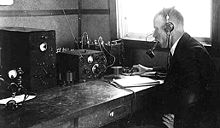Albert H. Taylor
Albert Hoyt Taylor (born January 1, 1879 in Chicago , Illinois , † December 11, 1961 in Los Angeles , California ) was an American electrical engineer who made important contributions to the development of radar .
biography
In 1896 Taylor began his studies at Northwestern University in Chicago. He was employed by Western Electric in 1899 and returned to university in 1900. He interrupted his studies again for lack of money and although only one semester was missing, he took a position as a teacher at Michigan State College . It was not until 1902 that he received his Bachelor of Science degree from Northwestern University. From 1903 to 1908 he taught at the University of Wisconsin – Madison . He then went on a study trip to Germany and received his doctorate at the University of Göttingen in 1909. He then entered the faculty of the University of North Dakotaone in which he set up an experimental radio station for studies on antennas and wave propagation. He continued his work in this function until 1917.
On March 13, 1917, Taylor was made a lieutenant in the US Naval Reserve Force. After the outbreak of World War I , he was hired as a communications officer for the Ninth Naval District. Until October 17, 1917, he was assigned the position of head of the communications department in Washington, DC . Then he was until July 25, 1918 Chief Telecommunications Officer at the Navy's transmitter in Belmar , New Jersey . He later took over a research laboratory at the Naval Aviation Base in Hampton Roads for the development of devices for communication on board aircraft. He then became head of the Air Force Air Force Radio Laboratory at the Naval Base in Anacostia, Washington DC He was appointed Corvette Captain of the US Naval Reserve Force on June 8, 1918 and promoted to Frigate Captain of the US Naval Reserve Force on November 14, 1918 . In 1922 he resigned from active service in the Navy, but remained in the service of the armed forces as a civilian employee.
In the fall of 1922, Taylor and Leo C. Young were conducting experiments with the radio station at the Potomac laboratory when they noticed that a wooden ship on the river was interfering with the transmission of the signals. In fact, they have successfully demonstrated the function of the first interferometric continuous wave radar . The following year the United States Naval Research Laboratory (NRL) was established and Taylor was appointed head of its radio division. In the early 1930s, as with German and British scientists, the idea of using a pulsing radio transmitter to detect targets and measure their distance arose in this department. Taylor instructed one of his assistants, Robert Morris, to build and test a prototype. This prototype was unveiled in 1934 and could detect an aircraft a mile away. In 1937 his team developed a practical on-board radar for the Navy called CXAM Radar - a technology very similar to the British Chain Home Radar system.
In 1929 Taylor became President of the Institute of Radio Engineers (IRE) and from 1936 to 1942 he was a member of the Communication Committee of the American Institute of Electrical Engineers . Both organizations were predecessors of the current Institute of Electrical and Electronics Engineers (IEEE).
Taylor remained with the NRL until he retired in 1948. He died in 1961, a few weeks before his 83rd birthday.
Awards
- 1927 - Taylor received the IEEE Morris N. Liebmann Memorial Award for researching short waves
- 1942 - IRE Medal of Honor , for excellence in leading the radio division of the Naval Research Laboratory
- 1944 - on March 28th, he received the Medal for Merit , the highest civilian honor in the United States of America
- 1959 - The Stuart Ballantine Medal from the Franklin Institute in Philadelphia .
Individual evidence
- ^ Page, Robert Morris; The Origin of Radar , Doubleday, 1962, pp. 65-66
- ^ Scientific Notes and News . In: American Association for the Advancement of Science (Ed.): Science . 99, No. 2571, April 7, 1944, p. 276. doi : 10.1126 / science.99.2571.276 . Retrieved November 6, 2011.
| personal data | |
|---|---|
| SURNAME | Taylor, Albert H. |
| ALTERNATIVE NAMES | Taylor, Albert Hoyt |
| BRIEF DESCRIPTION | American electrical engineer |
| DATE OF BIRTH | January 1, 1879 |
| PLACE OF BIRTH | Chicago , Illinois |
| DATE OF DEATH | December 11, 1961 |
| Place of death | Los Angeles , California |
